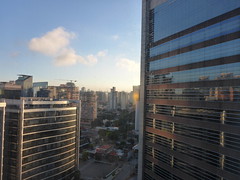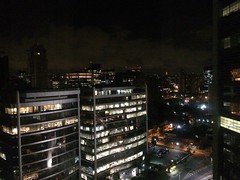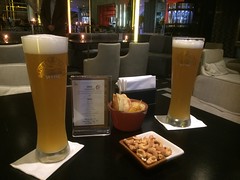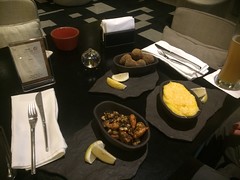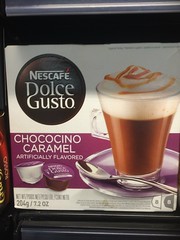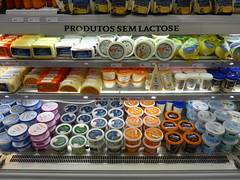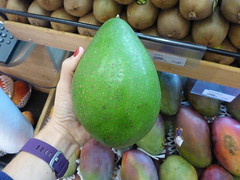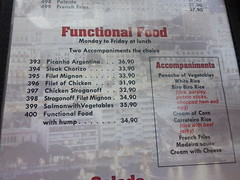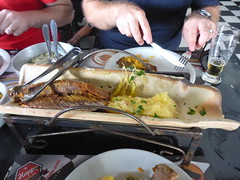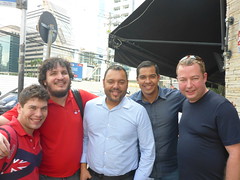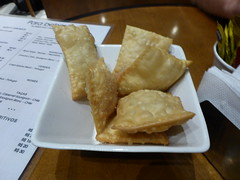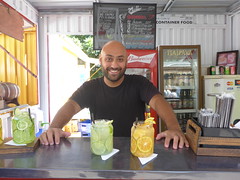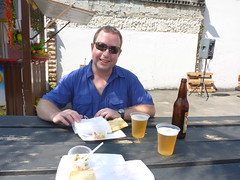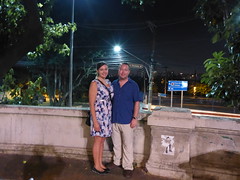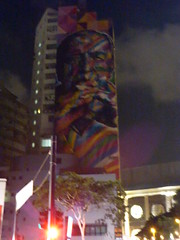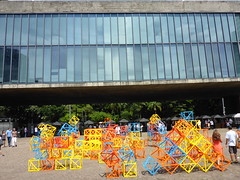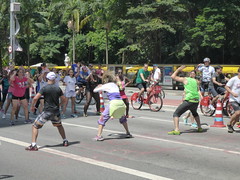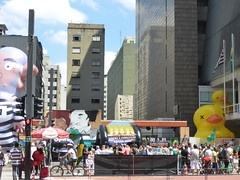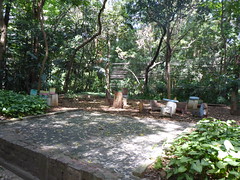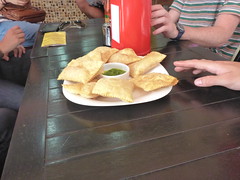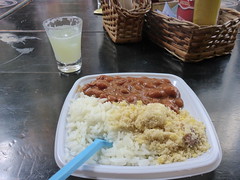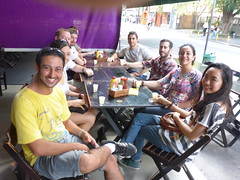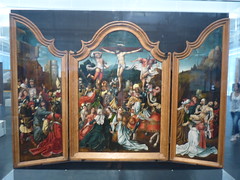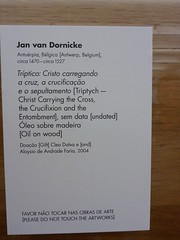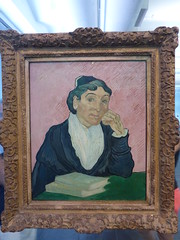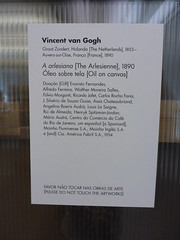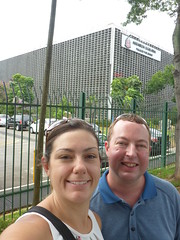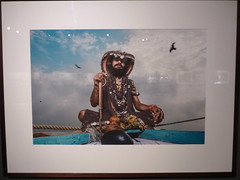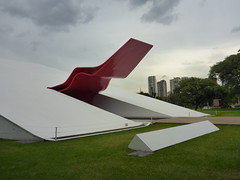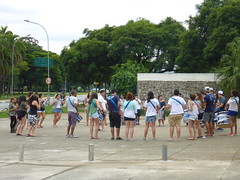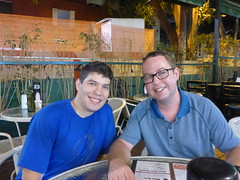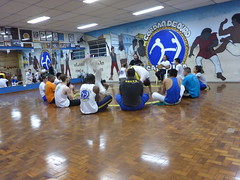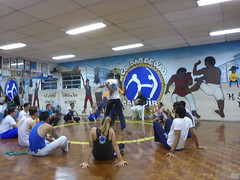We’re here!! 32 hours after taking off from Melbourne, to be introduced to everything Brasil has to offer.
São Paulo is big. Really Big. You just won’t believe how vastly hugely mind-bogglingly big it is… The city itself has 12 million people, but the greater metropolitan area has 21 million – around 90% of all of Australia!
We arrived Thursday night into the São Paulo airport, stayed long enough to write a quick message home to let the fambams know we were still alive and then headed to the first stop of our journey in São Paulo. Getting through the airport and customs was pretty quick but the taxi wasn’t – a long way about 75 minutes (and $60) later we arrived at the hotel. It was a bit of a funky looking hotel, with The Hub “food, art, drinks” downstairs, and a hotel staff member in full uniform “DJing”. Our room was pretty nice, and on the 14th floor (of 18) which gave us a nice view of the never-ending buildings of São Paulo.
Ricardo from Red Hat offered to take us out for the evening, which we thought about, but during the taxi ride home we got really tired. So instead we went downstairs for a beer and snack, before bed. At this point we decided it wasn’t a great idea to indulge too much at the hotel, it was $45aud for two 600ml beers and three tapas plates – delicious but expensive for Brasil.
On our first full day in Brasil, we went for a walk around the neighbourhood and grabbed a few things from the shops, including a bottle of Cachaça for AU$3.50. The fruit here is a monstrous size, the avocado was bigger than my hand and $1.50 per kilo. There are all sorts of flavours of everything, including tea for the coffee machine, and a whole section dedicated to lactose free cheese!
For lunch we went to a local “carne de Argentino” place with some of the Red Hat people. The English menu’s translation left some things to be desired, like “Functional Food with Hump” (we figured that “Functional Food” was an express lunch for workers), but the hump bit, after a few attempts and some translation from the Portuguese menu, turned out to be goat shoulder. We were planning on heading out for the evening but due to the political protests going on, we didn’t go to Paulista Avenue as planned, but went a local restaurant ourselves. Speaking almost no Portuguese it was interesting, but we managed to order some deep fried pastries filled with bacon or cheese, and fried chicken with chips! We even managed a few beers in there.
Saturday started fairly quietly, just going to the supermarket for a few items, and then packing to move to our first hostel. The taxi was interesting – we could have dealt with the language barrier, except the taxi driver didn’t know where we wanted to go to, even with the full street address and the route on James’ phone’s map. After 5 minutes of talking to another taxi driver, we finally headed off. The hostel was nice, and we got an “upgrade” from our private room with a shared bathroom, to one with an ensuite, with the caveat that one of the four nights we had to go back to the normal private room. Unfortunately they were also having water problems, so we couldn’t use any water for a few hours, and we needed to do some washing so we had clothes for tomorrow. Stumbling across a small food market in the afternoon we had a quick pitstop for some delicious caipirinhas with ginger and tangerine, so delicious!
We went for a walk on Avenida Paulista in the evening with Ricardo, seeing the many buildings at night. Paulista Avenue is the highest point in São Paulo and there is some amazing architecture there. The TV towers sit on top of the buildings and are brightly decorated with lights; there are at least four shopping centres that we counted, and huge amount of bars. Halfway along the avenue there is a huge jungle style park, filled with so much greenery, a strange but refreshing thing to see in the middle of the concrete jungle. Paulistas (the local people) are so friendly but walking down the street, still recovering from jetlag was very tiring! Avenida Paulista is a couple of kilometres long and our hostel was down some pretty epic hills at one end. Our step count by the end of the day was over 28000.
On Sunday the hostel still didn’t have enough water, and we couldn’t do washing because all of the Laundromats were closed. The water situation wasn’t amazing, apparently São Paulo is short on water – the government has turned down the water pressure to fix this. One would think this is a great idea until the water tanks (on the roof of the building) couldn’t be filled because there wasn’t enough water pressure. This resulted in the poor receptionist climbing up on to the roof with a hose to fill the tanks up… When the tanks were filled (and we could eventually have a shower) we were faced with a cold dribble that could vaguely be related to what we know as a shower.
After overcoming the water situation for the day we went for a walk around the city, seeing Avenida Paulista during the day. On Sundays the avenue is closed to traffic (apart from bicycles), there were many markets on, people having a Zumba danceparty in the middle of the street and so much food for sale. We tried a few of the local delicacies including coxinhas: the traditional ones are mashed potato stuffed with pulled flavoured chicken, then deep-fried (the non-traditional ones have different meats in them. So unhealthy but absolutely amazing!). We had our first night cooking in our hostel, after some grocery shopping problems like not understanding the question about whether we wanted a bag or not, then how we wanted to pay. Hand-waving and pointing at things we managed to get ourselves food, although from this experience we’ve both decided that we can no longer grocery shop together, we’re both too indecisive and disagree on the best way to walk around a supermarket!
Monday morning we went to drop off some washing, and again struggled with our lack of Portuguese. The first place we went to was very close, and after a few minutes of discussion with the owner, we figured out that they charged R$5 per piece and were more of a dry cleaner than laundry, however he gave us hand-waving directions to indicate there was another place around the corner. Going there, we continued to struggle with Portuguese, trying to explain that some items could not go into the clothes dryer. Eventually, we managed to get at least half of our clothes sorted out and in for cleaning (hooray for being an adult!). It was at this point we were told the price, which was almost half of our daily budget! Around 2.7kg of laundry was going to cost us R$95 (AU$35) – but we needed to do it.After navigating our way through the language barriers and back to our hostel we headed back up to Paulista Avenue to look around some more and meet up to a free food tour we had a flyer for.
The food tour met at MASP (the art gallery), which took us to a number of places for pastels (deep fried pastry with so many fillings: bacon and cheese, beef and cheese, cheese, chicken and cheese, a mixture of cheeses – all of the cheese!), a coxinha, açai and banana, a shot of caçhaca near the park, and then beans, rice and farofa (toasted cassava flour) with a small caipirinha. Our tour group was quite small, with a Brazilian from Manaus, an Argentinean, a Belgium/Japanese lady and three English backpackers, but apparently other days they can get up to 60 people. Along the tour James was advised to stay out of the sun because he was too white and would get burnt, there is not enough sunscreen in Brasil to cover him, although he has started getting a shirt tan! After the tour had finished we stayed and had a quick drink with the other guests then walked to Liberdade, the “little Japan” of São Paulo, for a look around. Liberdade is a strangely similar mix of Sunnybank and Chinatown in Brisbane. São Paulo has the largest population of Japanese people outside of Japan, which we found really interesting. In the Second World War, many of the Japanese came over to Brasil as refugees, when they arrived they settled in the later named area of Liberdade, which literally translates to Liberty.
Whilst gallivanting around São Paulo we knew we needed to catch a bus a few days later to São José dos Campos to meet up with William (from Red Hat and his wife Luana), then onto Paraty, we tried to buy tickets online. Unfortunately to do so, some of the bus companies require that you enter a Brasilian phone number to get an SMS with the confirmation code. Secure booking systems work amazingly, they’re not so great when you’ve got international phone numbers. William very helpfully let us use his number so we could book. The one to Paraty was even more trouble, with the site requiring you to enter your CPF (Brasilian national ID number) matching your credit card, and obviously foreigners don’t have one, so non-Brazilians cannot but bus tickets from some companies online. Hooray!
The next day; Tuesday?? We’re losing track of days! we visited MASP in the morning, which is small but has a lot of amazing art works, some very old (Some painted around 1200 AD). The history in this place is incredible, there are some famous artists’ paintings in here as well as some of the more traditional Brazilian art. The gallery was set out in chronological order with each of the pieces displayed behind glass. The preservation of the art was just amazing; this is, again, one of the places that our photos really don’t do the experience any justice.
Afterwards we went to Ibirupuera Park, the largest in São Paulo, and visited the MuseoAfroBrasil to learn a bit about the history of African heritage in Brasil. We managed to squeeze in a picture of parliament on the way to the park – we are up to 4 so far. Ibirupuera Park is huge! The park holds the Conservatorium of music, museums, art galleries and has a gigantic lake in the middle of it. Unfortunately we didn’t have time to see all of the sites there; however, we stumbled across a percussion band practicing just on the outer edge, which was pretty cool.
That evening we met up again with Ricardo and caught the subway to see his Capoiera group. Capoiera is dance-style fighting, when the Africans were enslaved here they developed the dance-style fighting because they weren’t allowed to fight. It was such a privilege to be invited to the Capoiera school and see it in action. São Paulo is very famous for pizza apparently, we decided that it was time to try some, we had half a Carne Seca (dried beef) and half what I think was called Baiada. For some reason the Brazilians like to put cream cheese on their pizzas, it’s not like Philadelphia Cream Cheese but a little closer to the “cheese” in a can that the Americans have. I can’t say that this was amazing on the pizza because of the quantity on it, but it was definitely interesting.
On our last day, we caught the subway to Tiete where the longer distance bus station. The subways are so quick and can get very, very full! In saying that, the public transport in Brasil is quite cheap, regardless of where you’re going it is the same price (equivalent to around $1.50AUD). We were smart and left ourselves enough time for things to go wrong in the bus station, which they didn’t really but the language barrier has been a struggle at times. Because we were organised and bought our tickets earlier in the week we only needed to go to a machine in the station to get them printed – a fantastic option for us. We couldn’t find the machine. We ended up at the bus company’s counter, and had trouble with the Portuguese once again. There are so many similar words between Portuguese and Spanish that we should be able to get the idea of what is being said; however the pace that it is being said makes it all sound like one word with lots of inflections. Luckily we had someone behind us in the line at the counter who asked, “do you speak English?” and could translate for us. After sugarcane juice for James and a coke for Dee, we headed off to the next city and the Costa Verde.
